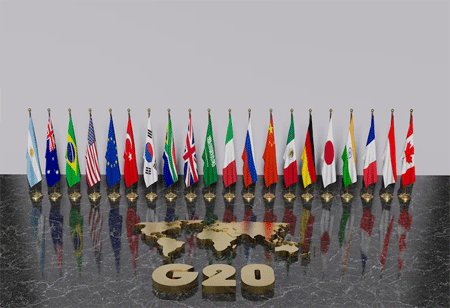
This year G20 summit has evolved from pure diplomatic exercise and converted to people’s movement. This year India is going to organize the most successful summit with highest participation or ‘janbhagidari’ and for this G20 events are being held across over 50 destinations in India, involving more than 45 lakh people. The whole foundation is standing on four pillars which are decarbonization, digitalization, ensuring equitable development, and de-escalating conflicts. This 18th G20 summit will be witnessing India’s overall progress and infrastructure and real estate development and technological advancement. India is working towards a multipolar world where each nation has a role to play. Few recent regulations like reducing compliance burdens and decriminalizing minor offenses made India an attractive destination for foreign investments. This pool of investments is expected to contribute significantly to India's target of becoming a $5 trillion economy in the coming years.
India has already signed few agreements to facilitate transactions in domestic currencies, promoting global engagement in Indian Rupee transactions. Our honorable prime minister Narendra Modi highlighted that, after the summit, there will be 220 meetings in 60 cities across all 28 states and eight union territories. More than one lakh participants from approximately 125 nationalities will be visiting our national capital and more than 1.5 lakh of people are involved to make this international event a grand success. Managing such a hugepool of delegates and attendees India is improving in power of capacity building and managing infrastructure, logistics, communication skills, hospitality, and cultural activities simultaneously.
Urban designer and architects highlighted such international events will be the trigger point and will surely play the pivotal role in the background of foundation of such national real estate assets. They also mentioned that, there should be a proper plan and robust system of using them for longer time, so that these structures cannot go unnoticed and transform into white elephant after few years. This will be one of the legendary liabilities of the host city.
Professor at the School of Planning and Architecture PSN Rao highlighted saying that, whenever an international event takes place here in India, national legacy comes out through national infrastructural assets. The foundation of Bharat Mandappam was a small part of a noble project of development of Pragati Maidan. But with passing time, these assets became obsolete without having any chance of restructuring. Now hosting of G20 summit will play the key role by presenting developed infrastructure and making India proud in global scenario.
Professor PSN Rao stressed on the positive impacts of the international events and said “We require more such facilities across the country. New infrastructure is required for revenue generation that goes into the maintenance and upkeep of the building itself. This is also required to project the country as a meetings, incentives, conferences, and exhibitions (MICE) tourism destination across the globe.”
Numerous halls along with Hall of Nation were demolished to construct the new advanced structure in Pragati Maidan. Now these structures were redeveloped and constructed International Exhibition-cum-Convention Centre which was costed Rs.2,700 crore. This newly constructed convention hall will house the prestigious G20 Leaders’ Summit between September 9 and 10.
Senior Associate Professor at the Centre for Environmental Planning and Technology, Ahmedabad, Jignesh Mehta delightfully exclaimed that our country needs to construct more such advanced construction in major metro cities to house state, national, international and various local events. He also highlighted that, if we only use such convention halls and auditoriums for international events to take place, it might get ruined very fast due to lack of maintenance and they will eventually become dead asset to us. He pointed out that, there should be few mixed-use complexes like shopping malls and commercial complexes around such structures.
An architect-based planner of Bangalore Smitha Kuttikat mentioned that these structures are generally timeless and they will generate job opportunity and will immensely contribute to the local economy. Such structures like Delhi should come-up in one or two major cities of southern India.
Till date, many international events like UNESCO Conference held in the 1950s, the Asian Games in 1982, and the Common Wealth Games in 2010 have all helped Delhi tremendously to undergo a massive urban and infrastructure restructuring. Delhi Development Authority actively planned for the Asiad Games Village on a land which was accounted for recreational purpose but it was later changed to residential and institutional and broadened the way to construct Siri Fort Auditorium and the Asiad Games Village.
Hosting international events is the widest path of developing the infrastructural design of the country and if we maintain it properly, our country will ride few steps forward in the ladder of infrastructure development and emanate as a developed country in the global scenario in future.
We use cookies to ensure you get the best experience on our website. Read more...
Copyright © 2025 HomesIndiaMagazine. All Rights Reserved.